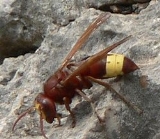
Oriental hornet
Encyclopedia
The Oriental hornet Vespa orientalis, is a hornet
which looks very similar to the European hornet
. It should not be confused with the Asian giant hornet
(Vespa mandarinia).
It is commonly found in the Mediterranean area, but can also be found in Madagascar and India. However, due to human introduction, its habitat is beginning to spread to South America up to Mexico.
The female queen measures 25 to 35 mm long; males and workers are smaller.
In males, the antennae have 13 segments, while females always have 12.
In 2010 a team of researchers from Israeli and British universities discovered that the yellow stripe in the hornet's abdomen
is capable of harvesting the sun's light and converting it into energy. In fact, the main metabolic activity occurs in that yellow pigment layer (i.e. the sun may be its main energy source). The process is made possible by a pigment called xanthopterin
. This might explain why the insects are more active during intense sunlight, unlike most hornets.
Hornet
Hornets are the largest eusocial wasps; some species can reach up to in length. The true hornets make up the genus Vespa and are distinguished from other vespines by the width of the vertex , which is proportionally larger in Vespa and by the anteriorly rounded gasters .- Life cycle :In...
which looks very similar to the European hornet
European hornet
The European hornet Vespa crabro, commonly known simply as the "hornet", is the largest European eusocial wasp. The queen measures 25 to 50 mm long; males and workers are smaller...
. It should not be confused with the Asian giant hornet
Asian giant hornet
The Asian giant hornet , including the subspecies Japanese giant hornet , colloquially known as the yak-killer hornet, is the world's largest hornet, native to temperate and tropical Eastern Asia...
(Vespa mandarinia).
It is commonly found in the Mediterranean area, but can also be found in Madagascar and India. However, due to human introduction, its habitat is beginning to spread to South America up to Mexico.
The female queen measures 25 to 35 mm long; males and workers are smaller.
In males, the antennae have 13 segments, while females always have 12.
In 2010 a team of researchers from Israeli and British universities discovered that the yellow stripe in the hornet's abdomen
Abdomen
In vertebrates such as mammals the abdomen constitutes the part of the body between the thorax and pelvis. The region enclosed by the abdomen is termed the abdominal cavity...
is capable of harvesting the sun's light and converting it into energy. In fact, the main metabolic activity occurs in that yellow pigment layer (i.e. the sun may be its main energy source). The process is made possible by a pigment called xanthopterin
Xanthopterin
Xanthopterin is a yellow, crystalline solid, that occurs mainly in the wings of butterflies and in the urine of mammals. Small microorganisms convert it into folic acid. It is the end product of a non-conjugated pteridine compound, and inhibits the growth of lymphocytes produced by concanovalin...
. This might explain why the insects are more active during intense sunlight, unlike most hornets.

